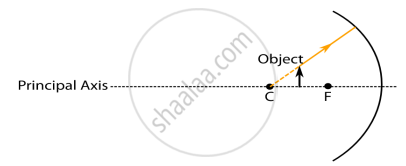Advertisements
Advertisements
प्रश्न
The radius of curvature of a spherical mirror is 20 cm. What is its focal length?
उत्तर
Radius of curvature, R = 20 cm
Focal length (f) = `R/2`
f = `R/2`
f = `20/2`
f = 10 cm
Hence, the focal length of the given spherical mirror is 10 cm.
APPEARS IN
संबंधित प्रश्न
"A concave mirror of focal length 15 cm can form a magnified, erect as well as inverted image of an object placed in front of it." Justify this statement stating the position of the object with respect to the pole of the mirror in both the cases for obtaining the images.
Draw ray diagrams to show the principal focus of a concave mirror.
List four specific characteristics of the images of the objects formed by convex mirrors.
A communications satellite in orbit sends a parallel beam of signals down to earth. If these signals obey the same laws of reflection as light and are to be focussed onto a small receiving aerial, what should be the best shape of the metal 'dish' used to collect them?
Draw the following diagram in your answer book and show the formation of image with the help of suitable rays:
If an object is placed at a distance of 8 cm from a concave mirror of focal length 10 cm, discuss the nature of the image formed by drawing the ray diagram.
Briefly describe how you would find the focal length of a concave mirror quickly but approximately
An object is 100 mm in front of a concave mirror which produces an upright (erect image). The radius of curvature of the mirror is ______.
One of the following does not apply to a concave mirror this is:
(a) focal length is negative
(b) image distance can be positive or negative
(c) image distance is always positive
(d) height of image can be positive or negative
Describe the nature of image formed when the object is placed at a distance of 20 cm from a concave mirror of focal length 10 cm
An object is placed at a distance of 10 cm from a concave mirror of focal length 20 cm.
Calculate the image distance.
An object is placed at a distance of 10 cm from a concave mirror of focal length 20 cm.
State two characteristics of the image formed.
At what distance from a concave mirror of focal length 10 cm should an object be placed so that:
its virtual image is formed 20 cm from the mirror?
The mirror which can form a magnified image of an object is:
(a) convex mirror
(b) plane mirror
(c) concave mirror
(d) both convex and concave mirror
The image formed by a concave mirror is of the same size as the object, if the object is placed
Give any two applications of a concave and convex mirror.
A child is standing in front of a magic mirror. She finds the image of her head bigger, the middle portion of her body of the same size and that of the legs smaller. The following is the order of combinations for the magic mirror from the top.

While looking at the above diagram, Nalini concluded the following.
- the image of the object will be a virtual one.
- the reflected ray will travel along the same path as the incident ray but in opposite direction.
- the image of the object will be inverted.
- this is a concave mirror and hence the focal length will be negative.
Which one of the above statements are correct?
You are provided with a concave mirror, a convex mirror, a concave lens and a convex lens. To obtain an enlarged image of an object you can use either
Which type of mirror is used in the following?
Shaving mirror
